#monocotyledon
Explore tagged Tumblr posts
Text

#IFTTT#Flickr#centralamerica#heliconia#heliconiaceae#liliopsida#panama#zingiberales#bloom#flora#flower#inflorescence#monocot#monocotyledon#plant
2 notes
·
View notes
Text
Open-Source Dendrometers for Real-Time Plant Water Monitoring
Scientists have long sought new ways to continuously monitor how changing water availability affects plants. Traditional methods of measuring water potential, a key indicator of plant water stress, require invasive sampling that damages tissue. Now researchers have developed entirely open-source instruments capable of tracking plant water status with unprecedented high frequency and…

View On WordPress
0 notes
Text
What is Monocot?
Explore the world of Monocot plants with our comprehensive guide. From stunning botanical features to essential cultivation tips, discover the beauty and diversity of monocotyledons. Whether you're a seasoned botanist or a curious gardener, unlock the secrets of these fascinating plants and enrich your botanical knowledge. Join Tutoroot for a personalised learning experience and ace your exams with confidence.
#monocot#dicot#monocotyledon#differencebetweenmonocotanddicot#monocotanddicot#monocotanddicotdifference#differencebetweenmonocotyledonanddicotyledon#monocotanddicotexamples
0 notes
Text
Today's Haiku with Picture 845

Lilies lined up
Surprisingly strong
Monocotyledons
They break through the pavement. Then they bloom.
並ぶ百合
案外強い
単子葉類
(2023.07.04)
7 notes
·
View notes
Text
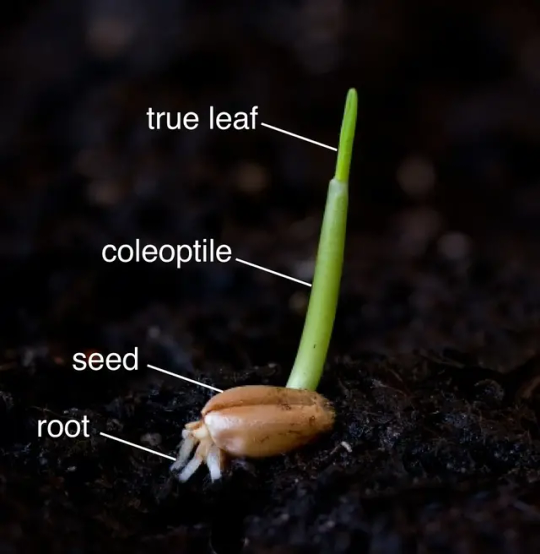
2 notes
·
View notes
Text
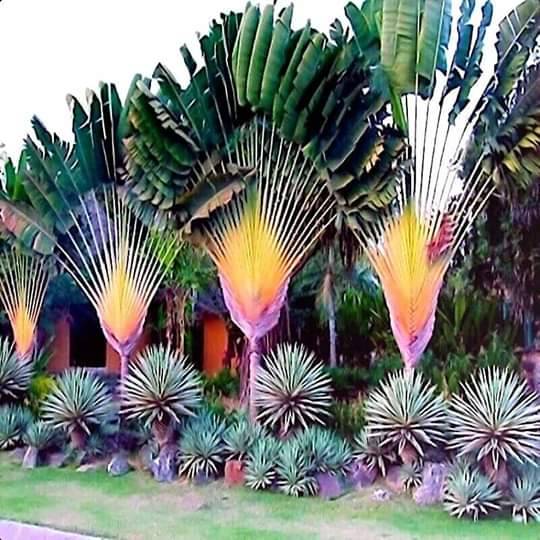
Travelers palm...
Ravenala is a genus of monocotyledonous flowering plants. Classically, the genus was considered to include a single species, Ravenala madagascariensis, commonly known as the traveller's tree, traveller's palm or East-West palm, from Madagascar. It is not a true palm but a member of the family Strelitziaceae.
2 notes
·
View notes
Text
Anthurium
Anthurium
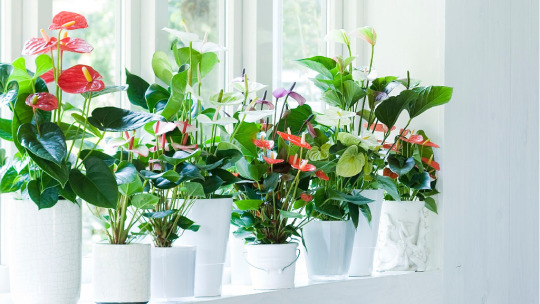
Anthurium flower plant is most famous in floral world. Anthurium andraeanum characteristic feature is an indoor ornamental plant with bright coloured spathe leaf. It can be propagated through seed, cuttings and tissue culture method.
Types

Anthuriums flower has more 1000 species depending upon their foliage leaves. There are tropical anthuriums, anthuriums passion pink, anthuriums chocolate, flame red, Mauritius white and sunshine orange.
Tropical anthurium

Red anthuriums flowers symbolize hospitality. It's referred as Flamingo Lily or painters palette. Tropical anthurium possesses attractive long-lasting inflorescence. Spadix is too short.
Anthurium passion pink
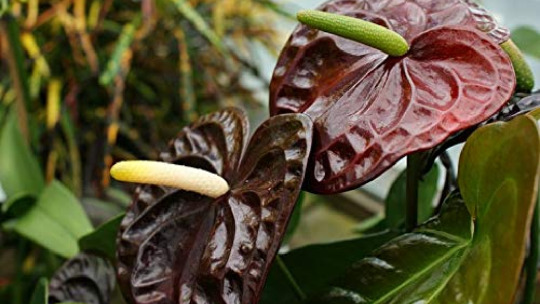
The pink colour plant is commonly referred to as an oilcloth flower and laceleaf. The pink colour flower calyx is too shiny to touch. Anthurium passion pink is a cut flower, potted flowering, foliage plant and an ornamental plant. Passion is a semi-terrestrial herbaceous plant. Pink flower leaves are long, tender, shiny and heart-shaped leaves.
Anthurium chocolate
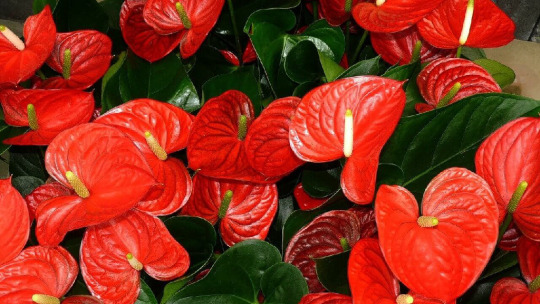
This Anthuriums is a monocotyledonous plant. Air-purifying plant nasa blooms arise from the leaf axil and produce flowers on each leaf which are too attractive. Anthurium chocolate flower leaves are long, Passion requires low temperatures and is popular as a pot plant. This plant is the ornamental shade plant and flower plant.
Anthurium flame red
It has a gorgeous look for its lovely blooming. Keeping Anthurium flame red fully indoors may not produce flowers, bright light is important to produce flowering. These look like shiny dark green and heart-shaped leaves.
Anthurium Mauritius white
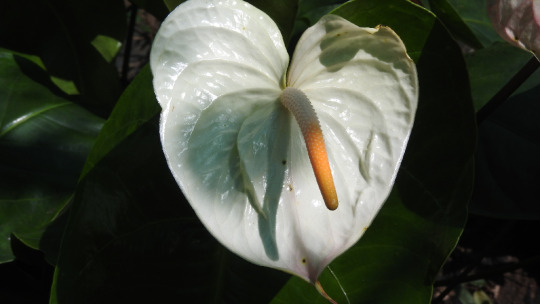
This anthuriums plant gets its name as its little spirit of nature. Anthurium Mauritius white flowers blooms all year round. Its splendid appearance can reduce human stress. This anthuriums flower is a rare species. Anthuriums flower plants are harvested a week. White petals resemble peace and positivity. Spathe has a gorgeous look.
Anthurium sunshine orange
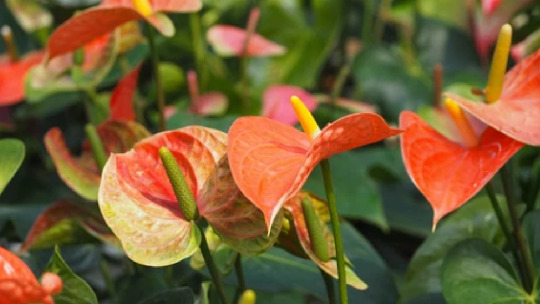
Anthuriums andraeanum plant is a NASA air purifier plant. Even every leaf carries flowers which are a sunshine orange colour. Anthurium sunshine orange is an evergreen tropical shrub flower. This flower is mainly used as focal arrangement for its colourful spathe. This is one of the best vastu plants.
Soil
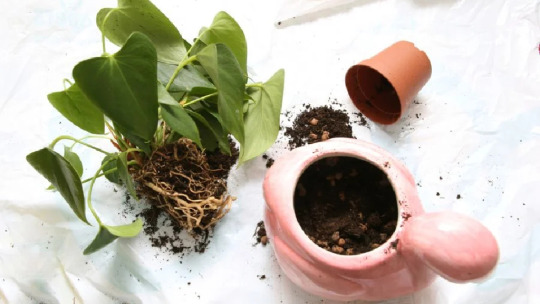
Love to grow in well-drained soil which can prevent the rotting of roots and stem. Anthurium andraeanum has an epiphytic aerial roots system. Anthuriums flamingo flower well grown in coconut husk.
Watering
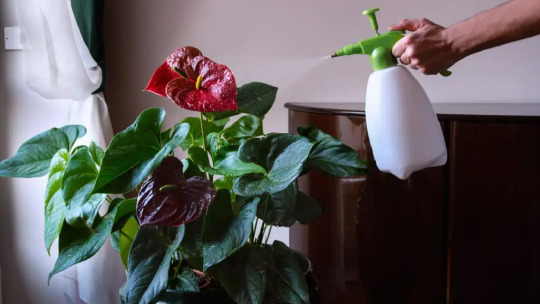
Anthuriums requires regular watering. This is a moisture-loving plant. Flamingo flower fleshy roots absorb huge water. Prompt watering enhances shoot growth. Watered in the early morning. Maintain relative humidity ranges between 70-80%.
Sunlight
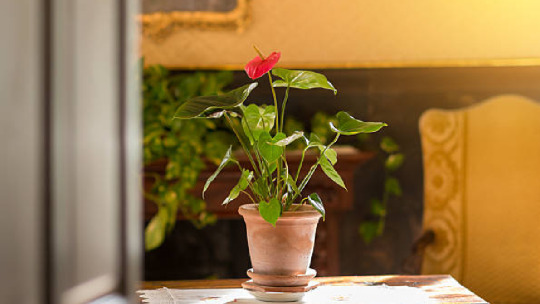
If planted as an indoor plant the pots placed near window sides (southwest direction) to getting best sunlight. If a garden plants needs bright light but not exposure to direct sunlight. Bright light enhances the bright colour spathe, velvety leaves.
Fertilizer
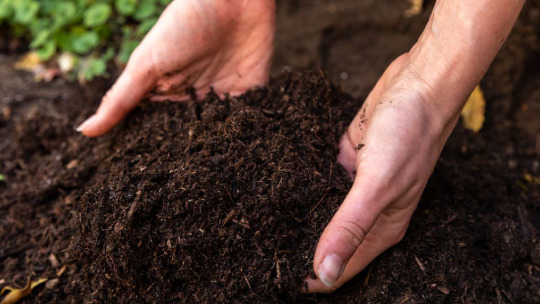
Application of well-decomposed organic manure at two months intervals. Flamingo flower soil mixed with manure, coco peat, and dried leaves. Add banana peels contain phosphorous, iron and calcium.
Repotting
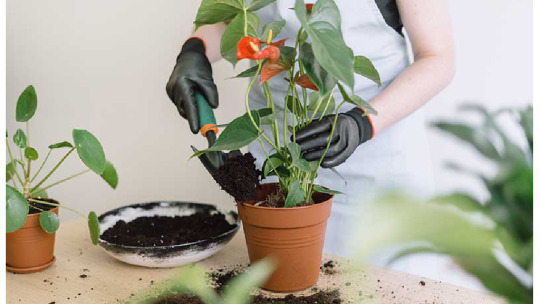
Repot the anthuriums plant at one year intervals. After six months the plant is ready for transplanting. At the time of repotting gently remove the plant from pots without damaging the root parts.
Pruning
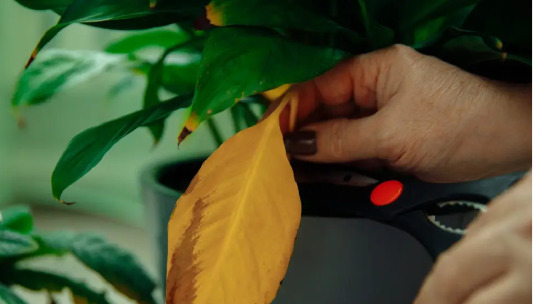
Prune the dried and old leaves. Remove the dried or mature flowers. Avoid over prune the plant.
Benefits
Best air purifier plants proved by NASA. Makes the environment with positivity. This plant reduces human stress. Its leaves clean the air from formaldehyde and xylene. This plant produces oxygen. Easy to propagate by tissue culture methods.
“Go green or we all will scream”
#Anthurium#Anthurium flower plant is most famous in floral world. Anthurium andraeanum characteristic feature is an indoor ornamental plant with brigh#cuttings and tissue culture method.#Types#Anthuriums flower has more 1000 species depending upon their foliage leaves. There are tropical anthuriums#anthuriums passion pink#anthuriums chocolate#flame red#Mauritius white and sunshine orange.#Tropical anthurium#Red anthuriums flowers symbolize hospitality. It's referred as Flamingo Lily or painters palette. Tropical anthurium possesses attractive l#Anthurium passion pink#The pink colour plant is commonly referred to as an oilcloth flower and laceleaf. The pink colour flower calyx is too shiny to touch. Anthu#potted flowering#foliage plant and an ornamental plant. Passion is a semi-terrestrial herbaceous plant. Pink flower leaves are long#tender#shiny and heart-shaped leaves.#Anthurium chocolate#This Anthuriums is a monocotyledonous plant. Air-purifying plant nasa blooms arise from the leaf axil and produce flowers on each leaf whic#Passion requires low temperatures and is popular as a pot plant. This plant is the ornamental shade plant and flower plant.#Anthurium flame red#It has a gorgeous look for its lovely blooming. Keeping Anthurium flame red fully indoors may not produce flowers#bright light is important to produce flowering. These look like shiny dark green and heart-shaped leaves.#Anthurium Mauritius white#This anthuriums plant gets its name as its little spirit of nature. Anthurium Mauritius white flowers blooms all year round. Its splendid a#Anthurium sunshine orange#Anthuriums andraeanum plant is a NASA air purifier plant. Even every leaf carries flowers which are a sunshine orange colour. Anthurium sun#Soil#Love to grow in well-drained soil which can prevent the rotting of roots and stem. Anthurium andraeanum has an epiphytic aerial roots syste#Watering
0 notes
Text
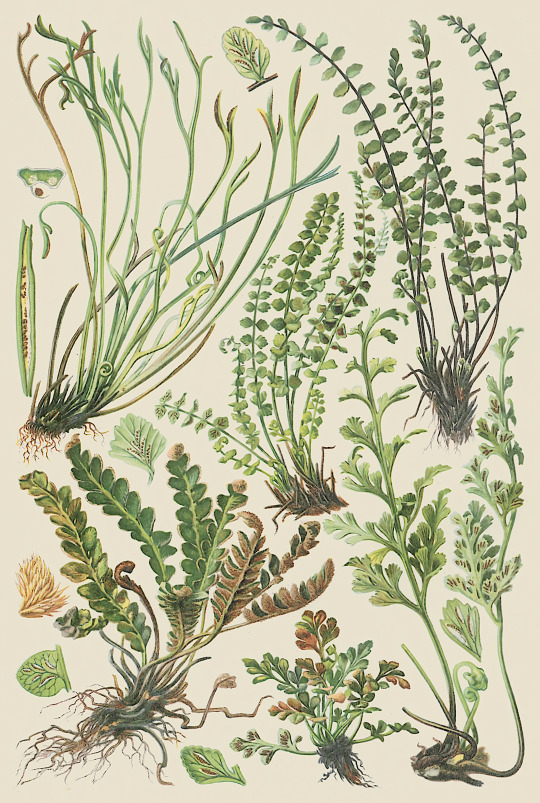
Illustrierte Flora von Mitteleuropa - Band I. Pteridophyta, Gymnospermae und Monocotyledones - Gustav Hegi - 1906 - via Heinrich Heine Universität Düsseldorf
1K notes
·
View notes
Text
Notes on the Class Battle, or, What is a Cotyledon?

The traditional class division of flowering plants is between monocotyledons, or monocots, and dicotyledons, or dicots. This is based on their morphology: based on how they look, flowering plants can generally be divided into plants with one cotyledon (“seed leaf” — part of the embryo, dicots have two parts to the seed and the plant that sprouts from it has a pair of first leaves, monocots have one part to the seed and the sprout has one first leaf.)
Gymnosperms have 2-24 cotyledons. Some species have a variable number of cotyledons.
Unfortunately, when people started looking at DNA and evolution, the neat monocot/dicot division didn’t hold up. Monocots are monophyletic (more closely related to each other than to anything else), and some dicots, the eudicots, are monophyletic, but eudicots and monocots are closer to each other than the other plants traditionally considered dicots.
So we’re going to do eight groups: the monocots, the eudicots, and...various plants traditionally considered dicots that are not eudicots.
Some of these groups are “basal angiosperms”, which diverged relatively early compared to the “core angiosperms”. We will be largely ignoring this distinction.
Many of these groups are technically orders. (The -ales suffix indicates the taxon is an order.) The Angiosperm Phylogeny Group recognize monocots and dicots as clades, but not ones with a traditional kingdom-phylum-class-etc ranking. We’re going to treat all of these groups as classes for the purpose of this tournament, because…it seems the most logical option? Because I can't find a system that divides angiosperms into classes that doesn't do the outdated monocot/dicot thing. I think things will get less messy when we get to the order battle. (If one of the orders wins, we’ll just skip that step and go to wherever the next branching is. Just like how if gnetophytes had won the phylum battle, we would have had to go straight to genus.)
75% of all angiosperm are eudicots, 23% are monocots, 2% are magnoliids, and a very small percentage are everything else. (But that very small percent includes some very cool plants, like star anise and water lilies.)
Monocot/dicot differences: monocots are less likely to be trees (although some are), monocot leaves are oblong or linear, usually with parallel veins, while dicot leaves are broad and usually have veins that spread out (pinnate or palmate.) Monocots have flowers with petals in multiples of three, whereas dicots usually have petals in multiples of four or five. Dicots are more likely to have a clear taproot than monocots. These differences are not 100% consistent and are more likely to be accurate for eudicots than dicots more broadly.
66 notes
·
View notes
Text

kai weverse update scream with me y'all @goldennika @sleepless-crows @leapingthroughworlds @monocotyledons @xiven @fatoompie
#the ballet flats!!#the ribbons!!#the short shorts!!#what do we do w this information I'm meant to be sane???#heuningkai#txt minisode 3#making out with the stylists
18 notes
·
View notes
Text

Monokit - The Baby Rabbit Pokemon
It has a very playful and excitable demeanor. Among its favorite games to play with trainers and other pokemon involves hiding among succulent plants and hopping out and surprising anyone who comes near.
-
And there's the redraw of the grass starter.
Monokit is of course based on rabbits but also agave plants and Mayahuel the Aztec goddess associated with agave. Kit is the term for a baby rabbit and mono comes from monocot or monocotyledon which is a category of plant that agave belongs to.
7 notes
·
View notes
Text
Random question. We know Mr.Plant's head js actually a flower but like- was it always a flower? Like maybe school has just ruined my perception of everything but did he have like leaves or a bud for a head as a kid and become a flower as a teen as his weird equivalent of puberty??? Or did he spawn into this world as an adult?? And is he ever going to turn into a fruit?? Is that what being pregnant is like for flower people?!? Who would be the father? And is he monocotyledonous or dicotyledonous? Wait let me[searching] okay he has 6 petals so he is monocot but like he had 8 at the beginning?? Dicots have 4 or 5, but I am not sure about their multiples as well?? Also does his vascular bundle morph into a pharynx midway through? Like how do the basically-not-alive xylem cells and lignin become liek actual living human tissue? Is that why he can't talk? Does he photosynthesize? Most flowers have both stamens and carpels/pistils, so could he be intersex?? Or like- partially. Does he even have stamens or pistils? I mean I don't see how he can have eyes and a mouth and them at the same time. What about a nectary? Does he pollinate? And going back to his vascular bundles, since he is mostly likely monocot, does that mean he has a bunch of tubes that eventually converge into his throat? Did he start life out as a seed? Will his xylem ever become bark? These and other questions fill my mind daily and trust me this is just scratching the surface (still haven't gotten into the transpiration, osmosis, seasonal change and toxin questions)
25 notes
·
View notes
Note
Nora ur cool,
Grass is a plant with narrow leaves growing from the base. A common kind of grass is used to cover the ground in a lawn and other places. Grass gets water from the roots in the ground. Grass is usually pigmented with the colour ‘green’. Grasses are monocotyledon, herbaceous plants.
The grasses include the "grass", of the family Poaceae (also called Gramineae). Also sometimes it is used to include the sedges (Cyperaceae) and the rushes (Juncaceae). These three families are not closely related but belong to different clades in the order Poales. They are similar adaptations to a common life-style.
The true grasses include cereals, bamboo and the grasses of lawns (turf) and grassland. Uses for graminoids include food (as grain, sprouted grain, shoots or rhizomes), drink (beer, whisky), pasture for livestock, thatching thatch, paper, fuel, clothing, insulation, construction, sports turf, basket weaving and many others.
Many grasses are short, but some grasses, like bamboo can grow very tall. Plants from the grass family can grow in many places, even if they are very cold or very dry. Several other plants that look similar but are not members of the grass family are also sometimes called grass; these include rushes, reeds, papyrus, and water chestnut.
Thank you! And uh woaw. Thanks for the uhhh... grass facts!
2 notes
·
View notes
Text
Today's Haiku with Picture 790

Iris bulbs
Recover quickly from even
The most brutal murders
They are strong because they are monocotyledons.
惨殺も
すぐ立ち直る
アヤメかな
(2023.06.24)
4 notes
·
View notes
Note
everytime i see your posts my mind instantly autocorrects your name to yuh-velle-belle(the pronounciation) and it sounds so french idk i thought i'd just let u know.
wow i might change my jser name to thay now
A common kind of grass is used to cover the ground in places such as lawns and parks. Grass is usually the color green. That is because they are wind-pollinated rather than insect-pollinated, so they do not have to attract insects. Green is the best colour for photosynthesis.
Grasslands such as savannah and prairie are where grasses are dominant. They cover 40.5% of the land area of the Earth, but not Greenland and Antarctica.[4]
Grasses are monocotyledon herbaceous plants. They include the "grass" of the family Poaceae, which are called grass by ordinary people. This family is also called the Gramineae, and includes some of the sedges (Cyperaceae) and the rushes (Juncaceae).[5] These three families are not very closely related, though all of them belong to clades in the order Poales. They are similar adaptations to a similar life-style.
With about 780 genera and about 12,000 species,[3] the Poaceae is the fifth-largest plant family. Only the Asteraceae, Orchidaceae, Fabaceae and Rubiaceae have more species.[6]
The true grasses include cereals, bamboo and the grasses of lawns (turf) and grassland. Uses for graminoids include food (as grain, shoots or rhizomes), drink (beer, whisky), pasture for livestock, thatch, paper, fuel, clothing, insulation, construction, sports turf[broken anchor], basket weaving and many others.
Many grasses are short, but some grasses can grow tall, such as bamboo. Plants from the grass family can grow in many places and make grasslands, including areas which are very dry or cold. There are several other plants that look similar to grass and are referred to as such, but are not members of the grass family. These plants include rushes, reeds, papyrus and water chestnut. Seagrass is a monocot in the order Alismatales.
Grasses are an important food for many animals, such as deer, buffalo, cattle, mice, grasshoppers, caterpillars and many other grazers. Unlike other plants, grasses grow from the bottom, so when animals eat grass they usually do not destroy the part that grows.[7] This is part of the reason why the plants are so successful.
7 notes
·
View notes
Text
Greetings, tumblr
I am Saino, but you can also call me something related to Grass because I greatly like grass.
I am a trans guy and use he/him pronouns. I do not really use 'aesthetics' but I have a way with words.
As my display name suggests, I like grass. The monocotyledon plant. I also like music and making music, writing poems, and reading books and fanfiction.
I play bass, and I have a guitar just.. hanging on my wall. My favourite genre is metal and my favourite band is Metallica.
It is nice to meet you all.
(English is indeed my first language, I just speak like this sometimes. I also might edit this post to update my intro)
3 notes
·
View notes